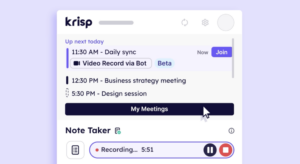Meetings are an integral part of any organization’s operations these days. It is impossible for a business to collaborate effectively without meaningful meetings, no matter what the meeting format – physical or virtual. Nonetheless, 95% of meeting attendees worldwide report missing portions of meetings, which demonstrates the importance of a well-planned meeting agenda template.
The latter is a powerful tool for ensuring that meetings stay on track, achieve their objectives, and make the most of everyone’s time. By following a structured approach, teams can facilitate focused discussions, encourage active participation, and drive meaningful outcomes.
Why Create a Meeting Agenda Template?
There are fundamental reasons why planning meeting agenda template can save the outcome of your meeting. Let’s discuss them one by one!
Meeting Transparency and Clarity
A meeting agenda template provides transparency and clarity for all attendees. It outlines the purpose, goals, and topics to be discussed, ensuring that everyone is aligned and aware of the meeting’s intended outcomes.
This clarity helps participants prepare adequately, contributing to more productive discussions and better decision-making.
Better Time-Management
Effective time management is crucial in meetings, and a well-designed agenda template can help achieve this goal.
By allocating specific time frames for each agenda item, participants can stay focused and ensure that critical topics receive the attention they deserve. This approach prevents meetings from running over or getting sidetracked by tangential discussions.
Efficient Decision-Making
Meetings often revolve around making important decisions that impact the organization. An agenda template helps facilitate efficient decision-making by providing a structured meeting format for presenting information, discussing options, and reaching consensus.
With a clear roadmap, teams can move through agenda items systematically, ensuring that all relevant factors are considered before finalizing decisions.
Improved Teamwork
Collaboration and teamwork are essential for successful meetings, especially in a work-from-home environment, where strategic and transparent communication is key for good outcomes. A meeting agenda template encourages active engagement and ownership by involving all participants in the agenda-setting process.
When team members contribute to the agenda, they feel valued and are more likely to participate actively during the meeting, fostering a collaborative and inclusive environment.
Essential Components of a Practical Team Meeting Agenda Template
Now that we understand the role planning meeting agenda template can play in our busy lives, let’s examine what it consists of.
Date, Time, and Location
The most basic components of a meeting agenda template include the meeting’s date, time, and location. This information ensures that all attendees are aware of when and where the meeting will take place, allowing them to plan and take notes during meetings accordingly and avoid scheduling conflicts.
Purpose & Goals of the Meeting
Clearly stating the purpose and goals of the meeting is crucial for maintaining focus and achieving desired outcomes. This section should outline the specific objectives or topics to be addressed, ensuring that everyone is on the same page from the start.
Agenda Items and Allocate Time Frames Per Topic
The heart of any meeting agenda template lies in the agenda items themselves.

These should be listed in a logical order, with each item accompanied by a realistic time allocation. This structure helps ensure that all relevant topics are covered while maintaining a reasonable meeting duration.
Talking Points
Some templates may include talking points or discussion prompts for each agenda item in addition to listing agenda items. These prompts can help guide the conversation and ensure that all critical aspects of a topic are addressed, promoting productive and focused discussions.
A List of Supporting Documents
Many meetings require participants to review and discuss supporting documents, such as reports, presentations, or proposals. Including these documents in the agenda template allows attendees to access and review them in advance, maximizing the meeting’s productivity.
How to Write A Meeting Agenda Template
Having said all of the above, let’s dive into the practical tips on how to plan and write a meeting agenda template.
Identify the Type
Before creating a meeting agenda template, it’s essential to identify the type of meeting you’re planning. Different types of meetings, such as status updates, brainstorming sessions, or decision-making meetings, may require different structures and approaches. Understanding the meeting’s purpose will help you tailor the agenda template accordingly.
Set the Standard Sections
Most meeting agenda templates share common sections, such as the meeting title, date, attendees, and objectives. Establish these standard sections as the foundation for your template, ensuring that essential information is consistently included.
Fix Time for Each Section
Allocating appropriate time frames for each agenda item is crucial for effective time management during the meeting. Consider the complexity of each topic and the level of discussion required, and assign realistic time slots accordingly. This approach will help ensure that all items are covered without running over the scheduled meeting duration.
Highlight the Purpose
At the top of the agenda template, clearly state the meeting’s purpose or objective. This will help attendees understand the meeting’s context and ensure that discussions remain focused on achieving the desired outcomes.
Clarify the Expectations
In some cases, the agenda template may need to include specific expectations or requirements for attendees. For example, if participants need to prepare materials or come prepared with specific insights, clearly communicate these expectations to ensure everyone is adequately prepared.
List Responsibilities
Assign specific roles or responsibilities to attendees for each agenda item. This approach fosters accountability and ensures that everyone understands their contributions to the meeting’s success. Additionally, it can help prevent confusion or overlap during discussions.
Attach Necessary Files
If the meeting requires the review or discussion of supporting documents, such as reports, presentations, or proposals, attach or link to these files within the agenda template. This step allows attendees to access and review the materials in advance, promoting informed discussions and saving valuable meeting time.
Design and Format
While the content of the agenda template is crucial, its visual presentation can also impact its effectiveness. Use clear headings, bullet points, and appropriate formatting to create an organized and easy-to-follow structure. Additionally, consider incorporating your organization’s branding or visual elements to create a consistent and professional appearance.
Examples of Meeting Agendas
To further illustrate the application of meeting agenda templates, let’s explore a few examples tailored to different types of meetings. However, these are editable meeting agenda template examples, so take them with a grain of salt and customize according to your needs.
Weekly Team Meeting Agenda Template:
Date: [Date]
Duration: [Time]
Agenda:
- Team Updates and Progress [x minutes]
- Provide updates from each team.
- Highlight notable achievements and key milestones.
- Key Achievements [x minutes]
- Recognize significant individual or team accomplishments.
- Challenges and Roadblocks [x minutes]
- Discuss any barriers hindering progress.
- Brainstorm solutions and assign follow-up actions.
- Action Items and Responsibilities [x minutes]
- Review the action items from the previous meeting.
- Delegate tasks and responsibilities for upcoming assignments.
- Next Week’s Goals [x minutes]
- Outline goals and targets for the following week.
- Ensure alignment with overall team objectives.
- Any Other Business (AOB) [x minutes]
- Open the floor for any additional topics.
- Address urgent matters or new updates.
Brainstorming Session Agenda Template:
- Date, Time, and Location
- Attendees
- Meeting Objectives [x minutes]
- Icebreaker or Warm-up Activity [x minutes]
- Problem Statement or Objective [x minutes]
- Brainstorming Techniques and Ground Rules [x minutes]
- Individual Brainstorming [x minutes]
- Group Brainstorming and Discussion [x minutes]
- Idea Evaluation and Selection [x minutes]
- Action Items and Next Steps [x minutes]
These examples showcase how meeting agenda templates can be tailored to specific meeting types, ensuring that all relevant components are covered and discussions remain focused on achieving the desired outcomes.
By following the guidelines and best practices outlined in this article, you can create agenda templates that promote productivity, collaboration, and successful outcomes for your team.
Krisp Can Help You Take the Next Step In Your Meetings
Krisp is an exceptional tool for enhancing the productivity and efficiency of meetings, particularly when used in conjunction with a well-structured meeting agenda template.
With its advanced AI Meeting Assistant, Krisp ensures noise-free virtual meetings, seamlessly transcribing, summarizing, and recording every detail. This simplifies the collaboration process and makes follow-ups more effective. Users can enjoy free unlimited transcriptions with 96% accuracy, regardless of the conferencing app they use, eliminating the hassle of manual note-taking.

Krisp’s real-time editing and collaboration features enable users to capture and share essential meeting points effortlessly. AI-powered noise cancellation ensures clear communication, regardless of the location, while the automatic meeting recording and transcription provide a comprehensive record of the meeting. This helps in assigning tasks, planning meeting agenda template with action items in the future, and setting deadlines efficiently.

By integrating with your calendar, Krisp automates note-taking and sharing, making it that much easier to create your next meeting agenda template. With Krisp, every meeting becomes a well-documented, productive session, allowing teams to focus on meaningful discussions and decision-making.
Key Takeaways From This Meeting Agenda Template Guide
Creating a well-structured meeting agenda template is essential for ensuring productive and efficient meetings. Here are the key tips and messages to remember:
Maintain Clarity and Transparency
A meeting agenda template provides clear objectives and topics, enabling all participants to prepare effectively and contribute meaningfully.
Manage Time Effectively
Allocate specific time frames to each agenda item to keep discussions focused and prevent meetings from running over.
Facilitate Decision-Making
Use a structured meeting format to present information and options clearly, making it easier for teams to reach well-informed decisions.
Encourage Teamwork and Participation
Involve all participants in setting the agenda, fostering a sense of ownership and active engagement.
Include Essential Components
Ensure your agenda template includes the date, time, location, purpose, goals, agenda items, talking points, and any necessary supporting documents.
By implementing these practices, you can transform your meetings into organized, productive sessions that drive meaningful outcomes.
In conclusion, a thoughtfully designed meeting agenda template is more than just a schedule—it’s a strategic tool that enhances collaboration, ensures efficient time use, and leads to better decision-making. Tools like Krisp can further enhance your meetings by providing noise-free virtual environments and automating note-taking and transcription. Embrace these best practices and tools to elevate your meetings from mundane to impactful, fostering a culture of productivity and engagement within your team.


